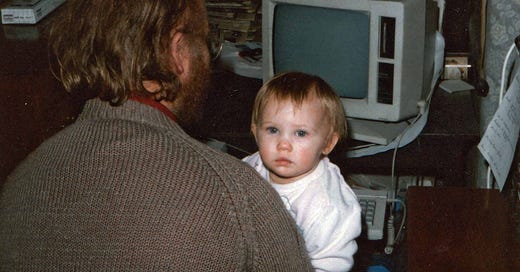I'm not saying this song is quite old, but when I first wrote it the iPad reference was to an Amstrad (the first computer I owned was an Amstrad PCW, the second was an Amstrad PC*). In other words, its trajectory is almost parallel to my career in IT. (At the time, I was working in the IT department at a major medical research organization, my second IT-focused job.) What's more, the Angry Birds DVD was originally a 7th Guest CD. It’s hard keeping up with technology.
I’ve recorded it a couple of times:
Slide version from the album Ten Percent Blues
Another version from the album Dinosaur Tracks (hat tip to Ken Bechtel for the album title!)
Hopefully, I’m still ahead of the curve on antique PC CPU specs, Moore’s Law (or House’s variant) and overclocking.
The reference to RS232C is slightly disingenuous: RS-232-C is the 1969 version of the standard, not hardware. I wouldn’t have mentioned any of this techy stuff if it weren’t for a ludicrous conversation in a pub in Shrewsbury with someone who apparently thought I was setting PC for Dummies to music rather than writing a mildly amusing blues parody.
And thanks are due to the guy in Guildford who recommended that I buy a copy of Sophos: since I worked at the time as a consultant for ESET, I didn’t need to…
Lyric
When I woke up this morning My laptop wouldn’t boot at all I said I woke up this morning And tossed my Tosh against the wall My baby took the mains adapter And the battery’s screwed beyond recall Well she left me for some guy With a 99GHz overclocked PC And now she’s interfacing With his RS232C (he’s a serial womanizer) She said my hard disk was too small To satisfy Her new spreadsheet I wouldn’t treat an iPad The way that woman treated me She fragmented my hard disk And ran off with my Angry Birds DVD Left me nothing but this boot sector virus And a copy of Wordstar version 3.3 Dah-diddy-dah-diddy-dah-diddy-dah….
* The PCW, if anyone cares, was a curious combination of computer and printer, running an unbelievable clunky word-processing application called Locoscript: it was horrible to use on long documents because it could only navigate through the file by scrolling down a screen at a time. Fortunately, it also ran CPM+, and I was able to acquire a version of WordStar that ran on it. I wouldn’t care to go back to it now, but it was much better than Locoscript in terms of real-time writing and editing, and produced files that other packages could use. (To be fair, a translator friend of mine at the time didn’t mind the slowness of Locoscript and appreciated its extensive character set.) Nevertheless, when I wrote a couple of basic editor/WPs later, I used classic WordStar command-key sequences. I even got my first programming experience on the PCW using primitive BASIC and Pascal packages.
Here’s a photo of my daughter and myself helping Stephen, my translator friend, with a little tech support.
However, when I started an Open University programming course in the early 90s, I needed a real PC running MS-DOS to run the necessary packages, so I bought the Amstrad 1640 PC and a daisywheel printer (kindly aided financially by my boss at the time, Professor George Janossy) and my wife inherited the PCW. The 1640 wasn’t altogether standard either, but IBM-compatible PCs were very expensive at the time and I had to get what I could afford. To give you some idea, my first hard disk held a magnificent 10MB (nominally) of data and cost me £250. When I started to work with a medical research charity not long after, I had shared use of a Compaq 386. I don’t know what the PC cost, as it was there before I was, but I did organize getting a 256MB RAM upgrade that cost around £1,000. I dread to think what the Macs and SunOS workstations I also shared would have cost.




